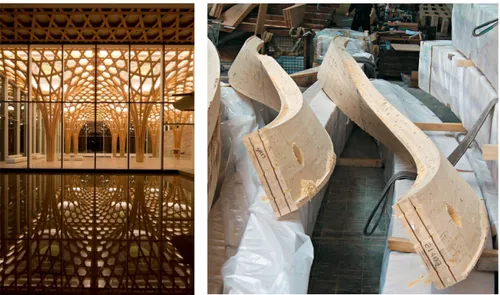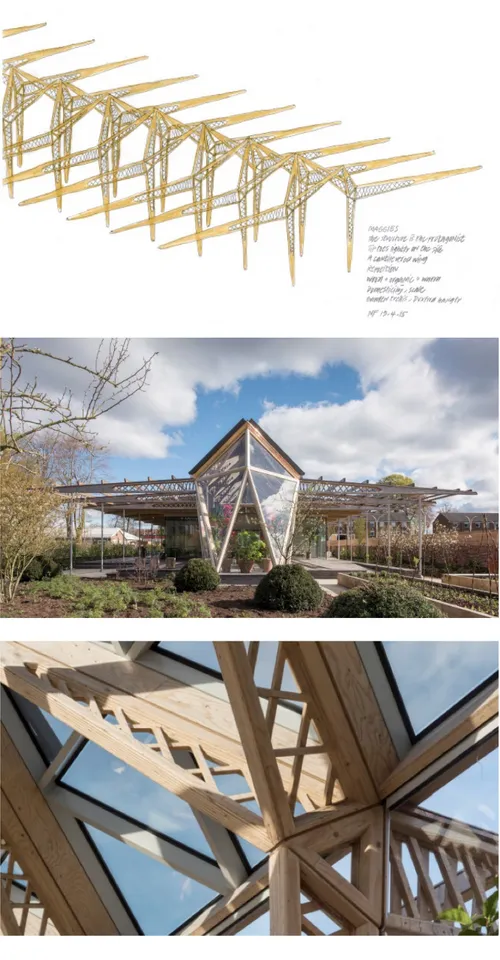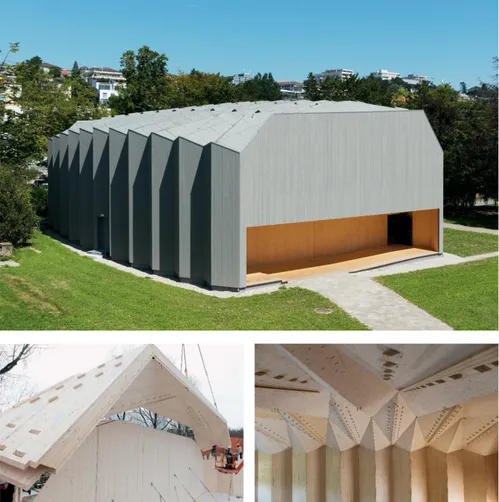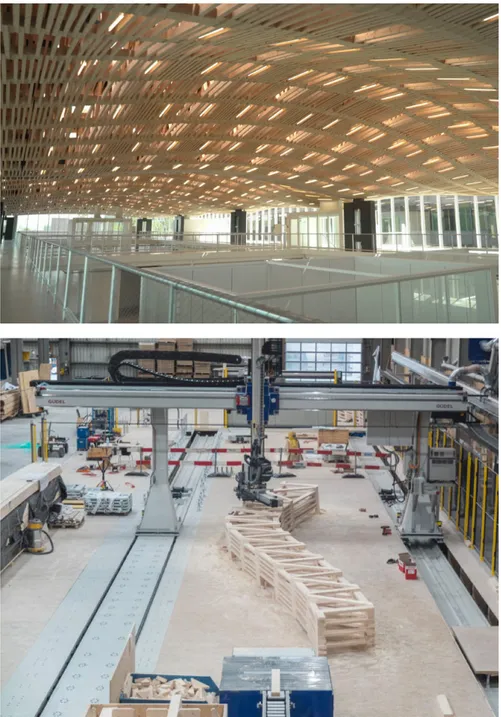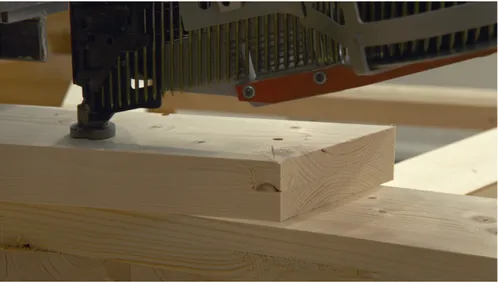€
Nuove metodologie di progetto tra
ricerca e professione nella fabbricazione
digitale del legno in architettura
New Design Methodologies Between
Research and Practice in Digital
Fabrication of Wooden Architecture
Salvatore Dario Marino,
Carlo Berizzi
Keywords: WooD; arChiteCture; DiGital DesiGn; performanCe; DiGital fabriCation Parole chiave: leGno; arChitettura; DiGital DesiGn; performanCe; fabbriCaZione DiGitale
The last twenty years of the recent history of architecture has been influenced by the introduction of digital tools in the design process both in research and practice. Today we are certainly witnessing a more aware phase of study in which computational potential introduces innovative methods of form generation based on specific perfor-mative requirements and material features.
In this sense, contemporary academic research together with experiments in archi-tectural practice is testing the technological developments through the definition of innovative design methodologies as an alternative to the conventional ones. From this premise, the paper aims to present and analyze case-studies representative of the application of digital tools in wood architecture based on analysis, simulation, associative modeling, generative parameters and digital fabrication tools.
The first two case-studies (Nine Bridges Country Club and Manchester Maggie’s Center) are inherent with the conventional design approach of architectural practice which applies digital fabrication in the final part of the process, in a logic of file-to-fac-tory production strategy. The other two projects (Sequential Roof and Vidy Theater Pavilion) are strictly related with academic research environment and, thus, they have a more experimental approach which better exploits the computational potential. The comparison of the selected projects aims to offers an overview of some of the possi-ble design methodologies and approaches enapossi-bled by computation which could be-come more common in a not too far future
L'ultimo ventennio della storia dell’architettura contemporanea è stato fortemente in-fluenzato dall'introduzione del digitale coinvolgendo l’intero processo dalla progetta-zione alla costruprogetta-zione. Oggi assistiamo a una fase di esploraprogetta-zione più consapevole in cui il potenziale computazionale a nostra disposizione introduce metodi innovativi di generazione formale sulla base di specifici requisiti performativi.
In questa direzione la ricerca accademica si affianca alla pratica professionale
mentando lo sviluppo tecnologico attraverso metodologie progettuali alternative a quel-le convenzionali. A partire da questi presupposti il paper presenta e analizza alcuni casi studio rappresentativi delle nuove metodologie progettuali rese possibili dalla combina-zione di diversi strumenti quali analisi, simulacombina-zione, modellacombina-zione associativa, parametri generativi, tecniche computazionali e di lavorazione robotica del materiale applicate al contesto architettonico delle costruzioni in legno.
In particolare, vengono analizzati due casi rivolti al mondo della professione, in senso più tradizionale (Nine Bridges Country Club e Manchester Maggie’s Center), e due casi relativi alla ricerca scientifica applicata condotta nell’ambito accademico (Sequential Roof e Vidy Theater Pavilion). Attraverso il confronto dei casi studio il paper mira ad offrire una panoramica di alcune delle metodologie rese possibili dalle tecniche di pro-gettazione computazionali e fabbricazione digitale che permettono un uso ottimizzato del materiale e delle sue caratteristiche.
INTRODUCTION
Academic research in architecture experienced profound changes in the last two decades since the exploration of digital technologies has been introduced in the design processes. Different stages of the current technological evolution influenced the understanding of digital potential in design disciplines defining a theoretical and practical background for the digital in architecture. The very first moment that could be identified as the beginning of the contamination of digital tools in design was the experimental project of Sketchpad, the PhD thesis of Ivan Sutherland at MIT in 1963. This tool allowed the designer to digitally represent points, curves and primitive geometries, through a hardware interface. The platform somehow provided the basis for the development of computer graphics and CAD (Computer-Aided Design) software which were commercialized some years later. The first extensive deployment of these applications in professional offices happens around the ‘90s, when IT (Information Technology) starts to take roots in different professional fields, introducing the computer as a cutting-edge tool for the improvement of working efficiency. In architecture, early versions of CAD software did not exploit a particular computational potential and basically provided the designer a digital version of the conventional drawing tools, allowing to work digitally with primitive and two-dimensional geometries.
Design software evolved in these years and they could be distinguished by degrees of complexity and articulation 1
(also corresponding to a chronological introduction in the market) in order to give a general understanding of the digital tools in architecture. The first category includes the 2D processing software, not only technical CAD softwares but also other programs used for graphics and communication of the project (Photoshop, Illustrator, etc.). The second category is the 3D graphic-based software, initially aimed at entertainment
world of movies and animations, was later absorbed in architecture and used to produce photorealistic images functional to the project presentation. The digital three-dimensional modelling in architecture proved to be a useful support for the designer, allowing for greater ease of modification and exploration of different solutions. The further development of these tools produced BIM (Building Information Modeling) software, in which the 3D model is no longer used only for visual purposes but also for the technical and economical management of large and complex projects, thereby facilitating the control of the entire process, in relation to the economic aspects and the construction phases. A further degree of complexity is represented by parametric modeling software and plugins (i.e.: Grasshopper for Rhinoceros) that enable three-dimensional modeling by acting on specific parameters set by the designer. To complete this classification, there is the analytical software (focused on different domains, from environment to structural) that helps to create informed models and to work in collaboration with algorithmic and scripting-based software. This combination allows to use the analysis’s results as parameters linking the behavior or shape of an architectural object to the studied performance. These last two categories, based on 3D modeling platform, enabled
performance-based design approaches
and generative processes which form a consistent field of exploration in current architectural research.
Contamination of technology and computing power gained during these last two decades provided the practical conditions, the infrastructure, for theoretical exploration. Since the early ‘90s the debate about new technologies in architecture starts to take shape, opening to new cultural horizons and design approaches. Gero (1994) 2, for
example, introduces a fundamental separation in the way of conceiving
design methods in connection with the
introduction of new technologies in
architecture, identifying two macro-areas of influence in computer aided design: the representation and production of the geometry and place of the designed objects, and the representation and use of knowledge to support the project. The first case refers to the use of CAD software, aimed at increasing the efficiency in the design and in the representation: the CAD software is then simply used as a drafting machine in digital. In the second case, it opens to a theoretical treatment of innovative approaches, such as performance-based design strategies, that exploit the computational potential as a support to a generative design process.
The exploration of Computer-Aided Design methodologies evolved from a mere search of formal complexity to computation-based design strategies able to introduce material behavior in the making process with a corresponding tectonic character.
In other words, the use of digital tools changed in the last two decades shifting from a representational to a generative digital practice. This significant paradigm shift, represented by the rise of new cultural landscapes, moves the focus of architecture from a primarily aesthetic domain to matters once considered secondary of structural, construction, economical and environmental issues. It is the overcome of the “Gothic” over the “Romanesque” 3, to say it in a symbolic
way, or, to be clearer, it is a shift from an object-oriented design to a process-oriented one.4
In terms of architectural culture this can be analyzed as an attempt to move the debate away from the decorative scenography of Post-Modern paradigm, which privileged the appearance of aesthetics, towards a global conception of performance. Contemporary research in architecture is, in fact, focusing on a more
objective and scientific framework where
the efficient use of resources (materials) acquires a primary importance over the traditional approach. This does not represent the end of the creative process in favor of an aseptic and distant one, the architect changes his role of director
METHODOLOGY
This paper analyzes the digital-based approaches in timber architecture presenting case-studies that are classified in two principal categories: academic research and contemporary architectural practice.
The study methodology is based on the comparison of such case-studies showing how digital processes can lead to different processes and fabrication strategies. The selection of the projects has been based on simple criteria according to which the design should: feature a timber self-supporting structural system (excluding decorative use of the material); be a full-scale and fully functioning realized building (excluding temporary small scale pavilions); be realized with digital fabrication tools off-the-grid of the serial industrial production; be constructed within the last decade (2008/2018) in order to avoid excessive differences due to technological development. These criteria limited the selection to the most relevant international projects which fully express the possibilities offered by digital tools not only in terms of innovation of the architectural language but also as tectonic systems which reintegrate the value of architectural detail as generative design principle.
The case-studies which belong to architectural practice feature a more conventional process where the architect
makes some choices in the design phase which are solved in a second phase of fabrication and construction. Therefore, in these cases the technology is employed in the final part of the process to produce non-standard timber components free from the seriality of industrial production. The selected projects for this category are the Nine Bridges Country Club by Shigeru Ban, and the Manchester Meggie’s Center by Norman Foster. On the other hand, the projects that come from academic researches experiment innovative strategies where the form is open to external factors that determine (or are determined by) the fabrication and assembly system and introduce material behavior and performance since the early design stages. In these cases, there is a strong relationship between the construction strategy, the architectural detail, the material behavior and the global form which is achieved through an integrative workflow. Due to the different method of application of digital tools and to the different level of complexity of the two categories, the academic projects will be described through a more in-depth analysis.
praCtiCe-baseD approaCh: nine briDGes Country Club, shiGeru ban, 2009
Shigeru Ban is an architect that has demonstrated, through many of his projects, an interest in innovation and in the practice of alternative design choices. The Nine Bridges Country Club is a private clubhouse of a golf course within a green context few kilometers away from Seoul, South Korea; it is the oldest project analyzed in this framework since it showcases innovative use of customized timber laminated components. The complex is divided in three buildings, the clubhouse for regular members, the VIP members area and the VIP members accommodation. Each building is characterized by a different structural system that reflects the cultural values of traditional methods in South Korea. The focus, for the purpose of this paper, is the building for the regular members of the club, it features a hexagonal timber grid system that defines the structural principle for all the roof. The constructive and structural logic is visible to the visitor in the main hall, which is the part where the system can be seen integrally from the columns
Figure 2: External view of the Nine Bridges Country Club designed by Shigeru Ban. From this picture emerges the structural system based on a regular layout of timber columns that support the big roof and strongly define the internal spaces.
from form-maker to controller of a more complex generative process where his creativity is not the only agent concurring to the final outcome. Contextually even fabrication technologies evolved implementing traditional industrial processes and creating the opportunity to experiment a seamless process based on an integrative workflow from design to production. Today, this field of research in architecture can act as antechamber of innovation for architectural practice and it contributes in the formation of a theoretical and practical background for the construction industry.
to the roof texture. The design character is based on this structural system that employs wood in an alternative way. (Fig.3)
The process is close to a conventional one in which the architect makes the design choices without any computational tool. This defines a sort of top-down process which takes into account the potential of digital fabrication for the construction phase. The timber beams, that composes the articulated grid-shell, are complex double-curved elements realized in two steps. In the first step the wood is laminated using formworks to achieve the principal curvature, while in the second step the final geometry of the components is reached by cutting off the excessive material with robotic wire cutting or CNC milling machine. This allows to obtain a special customized component from a generic single-curvature component. The creation of formworks for single-curved timber lamination is relatively complex but it is still achievable in a conventional industrial workflow, although it slows down the production process because different formworks must be prepared in relation with the different curvatures present in the project. On the other hand the second direction of curvature needs to be achieved through a system which is off the grid, in this case once the initial geometry is input in the robot or machine, it does not matter, within a certain threshold, how complex is the second curvature direction since for the robot can process hundreds of different components at no additional cost. Computation allows to manage the complex geometries involved through a parametric digital model from which is extracted the geometry of each component. An analogous system, even more articulated, has been employed by the same architect in the project for the Center Pompidou Metz, which is a double-curved free-form timber shell as a big roof.
praCtiCe-baseD approaCh:
manChester’s maGGie’s Center, foster anD partners, 2016
This case shows a similar strategy on a different and more optimized structural layout. The project for the Maggie’s Center in Manchester, designed by Foster and Partners in 2016, is based on a timber frame structure where the components have been customized to achieve innovative tectonics of wood. The building is a place of refuge for people affected by cancer, therefore the space is meant to be peaceful, quiet, familiar and it fosters the relationships. Wood warmness and visual permeability become the key elements of the design. The structure is a redefined timber frame layout where timber beams and columns recall the structural principles of trusses. (Fig.4)
This strategy allows to have wide cantilevers that covers a sort of terrace space all around the building, while keeping the structure very light, efficient and visually permeable. The frame is based on the triangle shape, it becomes a linguistic and functional element that generates the architectural character of the building. The use of CNC machines to customize structural components allows to maintain a coherence between the tectonic, the structure, and the spatial perception that goes beyond conventional timber frames and related joints. The building features a special
triangular node that joins three beams and one column, and it is repeated in all the structure. (Fig. 5)
Once again, analogously to the previous case-study, the design method follows a conventional process which is upgraded in the final part with digital tools, software and hardware, that allow the production of special component beyond the industrial logic of serial production. Even in this case, a similar process has been used by the designer in another project, the Kulm Eis pavilion (2017). Once the methodology is tested and verified in a full-scale project, the same approach can generate other innovative designs which could offer further inputs to the applied strategy.
researCh-baseD approaCh: viDy theatre pavilion, ibois lausanne, 2017 The research conducted by IBOIS laboratory at EPFL Lausanne provides an essential method for the stress transfer in surface-active structures as the timber folded plates, and it fosters an alternative and efficient use of planar products available in the construction industry since a single system works both as enclosure and structure. The study on the integral timber joints opens the way to alternative connection techniques for timber plates structures and unveils the
Figure 3: Left, view of the internal hall in which the columns are protagonists of the space, it is interesting to note how the timber components seamlessly change from vertical to horizontal. Right, example of doubly-curved timber components.
tectonic character of such assembly and structural system in the definition of dynamic spaces. From a compositional point of view this layout recalls the projects of FOA, such as the Yokohama ferry terminal or the retail complex in Istanbul, of the early 2000s where the fold expresses the architectural dynamism of spaces. The folded plates layout not only finds theoretical connections with the recent history of digital architecture, but it also carries a structural meaning that enhances the tectonic correspondence between architectural space, digital crafting technique, material performance. This method, by employing certified cross-laminated timber panels used in construction market, found less difficulties in the application of full-scale buildings, compared to other experimental wood processing strategies. (Fig.6)
Although labeled as temporary pavilion the project realized under the supervision of Prof. Yves Weinand, director of the IBOIS laboratory, contributed to reduce the gap between the research in digital technologies for architecture and the construction industry.
The pavilion for the Vidy Theater in Lausanne is a temporary construction built in the campus of the Vidy Theatre where is also located the principal building of the 1964 and two other permanent buildings. The pavilion, built in 2017, substitutes a temporary heated tent creating both a better place for people and an opportunity for a technological transfer from research to practice.
The theatre has a flexible layout with retractile seats that can be closed when a larger space is needed. The scene is not elevated so that it makes easier to adapt the space to multiple functions such as exhibitions or performance. (Fig.7) The connection technique employed in this pavilion, which is the current research focus at IBOIS, is based on timber mortise and tenon joints without additional fasteners. The assembly of double layered folded plates becomes, once again, together structure and enclosure and, moreover, it defines
Figure 4: Top: Sketch that exemplifies the structural layout composed by a repeated cross-section joined on the roof with diagonal components. The connection of the structural elements is solved through a customized trianguar node. Bottom: external view of the Maggie’s Center. Sketch ©Norman Foster; Photo ©Nigel Young / Foster and Partners.
Figure 5: Detail of the triangular node and the customized components. The beams and columns have been lightened carving out the material in excess. Photo ©Nigel Young / Foster and Partners.
the tectonic of the building, further highlighted from the connections visible from the inside. The theatre is assembled from prefabricated customized timber panels 45mm thick which were cut with a CNC machine.
The assembly system is based on a double layer with a distance of 300mm that improves the stability of the roof/ beam forming a stiff arch-like shape that concentrates most of the bending stresses along the folds. The stress distribution was controlled on the digital model and the shape was adjusted to have a homogeneous situation through the whole structure. The span of the arches goes from 20m to 16m without any additional support in the middle. The space between the two layers is also used to solve functional issues integrating sound and heat insulation. The project coherently responds to the sustainability issues using old recycled paper and wood leftovers for the insulation, moreover the use of local wood and the CO2 absorption during its growth ensures a low carbon footprint of the whole construction.
This project demonstrates how the use of technology fosters an integrative transfer of methodological and technological knowledge from the research environment to the architectural practice. The development of an integrative workflow for a full-scale construction is a relevant contribution that innovates timber construction process. Moreover, the connection detail of integral joints (be it dovetail or through-tenon joint) represents the tectonic expression in the final structure. The detail of mortise and tenon timber joints, reflects the
tekné employed – aided by digital tools
– and its relative structural purpose, defining the tectonic character of the construction. Such direct relationship appears clear in the theatre pavilion, although many architectural issues remains unsolved given its character of temporary construction, where the system aesthetic reflects the essence of the construction principle.
researCh-baseD approaCh: sequential roof, eth ZuriCh, 2017
Contemporary research in Robotic Timber Construction (RTC) experienced important advancements thanks to¬ Zurich ETH experimental approach. This research direction has been recently materialized in a full-scale structural roof component for the new building of the Arch_Tec_Lab research facility, located at the Hönggerberg campus in Zurich. This structure is among the first – perhaps the first – robotic-assembled permanent construction opened to host public working there, therefore, differently from temporary demonstrative pavilions, it had to pass several steps for checking structural resistance and technical issues within the standard required by Swiss building regulations. It has been defined as “real-scale demonstrator
showcasing innovative approaches to architecture and construction in terms of parametric design, digital fabrication, sustainability, HVAC (heating, ventilation, air conditioning), MEP (Mechanical, electrical and plumbing) and structural systems”. 6 The design was developed
by Gramazio and Kohler research group which is investigating in the field of automated robotic construction since 2008.(Fig. 8)
The roof covers a total area of 2.300 m², it consists of nearly 50.000 different timber elements design with a parametric model based on customized algorithms and then cut and assembled by a robot. The building is a rather simple structure 28m x 80m with a central double-height area, the primary structure is a steel frame supported by twelve columns, while the robotic assembled roof-trusses work as
Figure 6: External view of the Vidy Theater Pavilion. Design ©IBOIS; Photo ©Ilka Kramer.
Figure 7: Left: Assembly phase of one section in construction site. Right: internal view of the assembled structure. Design ©IBOIS; Photo ©Ilka Kramer.
secondary beam structure with a regular span of 14.7m and 1.15m wide, each truss is made of 23 layers 50mm thick. The layering logic is based on a basic truss form and consists of continuous top and bottom cords with diagonal webs: between every three chord elements there is a layer of web elements. Top and bottom chords to be continuous need in fact to be composed by three alternated layers while the webs lie in one layer. One of the advantages of this layout is that it allows a great flexibility in the curvature variation of the truss profile, which is the basic architectural principle of the project. The structural approach and the truss layout generate a sort of redundancy of material thanks to which some individual elements may occasionally be left out if needed. The roof package is composed by a primary steel structure, on which lies the timber structure integrated with artificial lightning, windows for natural lightning, waterproof and insulation layer, sprinklers according to fire regulation, smoke exhaust.
The integration of the timber structure with many functional parts demonstrate another level of success of this project, even the technical components are designed and arranged in the space following the architecture of the building, they are not treated as subsequent additional layers.
The trusses have been differentiated and structurally optimized according to local needs, therefore three different cross section heights are employed: 115mm, 140mm, 180mm. For the construction process the material was organized in untreated slats 10m long, joined through finger joints. (Fig. 9)
Even the connection system had to be fully-automated therefore the hypothetical solutions and tests were performed on systems that could be easily integrated in the robotic construction process. At first a fast-curing glue connection was considered, but the glue typically needs a considerable pressure to work efficiently and this could cause problems on a skewed stack of timber slats. Therefore,
Figure 8: Internal view of the Arch-Tech building. ©Gramazio Kohler Research, ETH Zurich.
Figure 9: Set-up of the assembly space. The workflow is designed to allow the full automation of the whole component, from the full-length timber slat (10m) to the cutting andfixing in its final location with nails. ©Gramazio Kohler Research, ETH Zurich.
another fast technique was a mechanical connection using nails. Nails are ductile and have the advantage to compensate the brittle behavior of wood under structural failing, offering a smoother stresses re-distribution instead of a sudden collapse. On the other hand, nails can cause fiber splitting in wood if not carefully positioned.
Swiss norms provide some distance parameters to respect for the nailing of wooden structures in relation to the diameter of the nail, the resulting safe area around each nail is represented by an ellipse with its major axis parallel to the grain direction. Every nail connects two layers, thus it must be considered not only the position of the other nails in the layer below but also the ellipse orientation according to the grain distribution of both layers.
Finally, the joints are structurally analyzed to determine the number of nails needed which, throughout the whole structure, range from a minimum of 4 to a maximum of 20 nails per joint. (Fig.10)
The methodology employed in RTC goes beyond the established design phases developing concurrently concept, structural layout and behavior, and construction details.
Therefore, the conventional design process needs to be reconsidered including different types of information within one integrative workflow. Parametric design and computational tools are helpful in the generation of informed models. In this project the team developed an algorithm-based model to generate the volumetric representation and an abstracted data model for the structural analysis and fabrication simulation.
An additional algorithm was written to automate the setup of the structural calculation based on the previous model, in a way that changing the first model the new structural calculation is obtained. The results of the structural analysis were processed by the fabrication simulation algorithm which also generated the nailing pattern.
The initial model of the roof, with all
slats of the same size (cross-section 50x100 mm), demonstrated, through the structural analysis to not be resistant enough, therefore local changes of individual elements were necessary. In an iterative cycle, the changes to the geometrical model, based on parameters, inform the structural analysis model which gives back the new results. The changes, at this stage, were based on the structural behavior of the timber members and of the nailed joints. To equilibrate the internal forces the cross-section of some members was increased, while to guarantee the required number of nails in a joint the overlapping areas were increased by extending the slats ends or increasing their cross-section. The changes were performed through several iterations till reaching the final structure which correctly responded to the structural analysis. Once the geometrical model passed the structural analysis tests no further post-production was necessary thus this information was directly used for the fabrication process.
The final design was digitally checked, through the structural analysis algorithm after all the necessary iterations, and further validated through physical experiments. In an initial phase of the physical test a series of specimens of single node consisting of three timber slats were checked with different configurations – assembled at different angles between them: 0°, 45°, 90° – and
with different nail patterns. The data received from the physical tests were re-introduced in the model to refine the calculations adjusting the geometry where needed. Before the construction the design was further checked by testing 15 full-scale trusses. At the same time the fabrication of these trusses was useful for testing the robotic assembly process.
The robotic fabrication of such structure required a special layout with a considerable workspace and a six-axis overhead gantry robot which was set up at ERNE AG Holzbau. 8 The six-axis
gantry robot features also a mechanical wrist with exchangeable end-effectors, a sawing table, a tool changing rack and a repository of 10m long timber slats of three different sizes. The 168 trusses were fabricated layer by layer following the process: the robot picks the timber slat and cuts it automatically with a circular saw at the required length and angle derived by the digital model; the piece is then moved to the target position on the workspace and fixed preliminarily with one nail at each end to keep the position; in some cases, when additional trimming is necessary, the end-effector is changed with a circular saw and adjust the laced timber slat, this is also due to the fact that the layers are slightly skewed to form a double curved surface in the final assembly; before starting with the next layer a camera on the robot
Figure 10: Detail of the nailing system, the tool is mounted on the same end-effector of the robot used for the assembly of the whole truss beam. ©Gramazio Kohler Research, ETH Zurich.
checks for deviations or errors.
This project brings, for the first time, an experimental fully automated assembly system at the full scale of a permanent building; it represents a fundamental model in the change of industrial production of building components. The approach experimented here liberates the design strategy from the constrains of conventional industrial logic based on standardization and repetition, but it also finds a way to re-organize the production of timber components for customized solutions with a general set up which, once established, can be employed in further projects. This approach additionally allows the fabrication and assembly of the components to take place almost simultaneously, reducing the logistics issues and the need of labeling each component and re-assembly them in the construction site. Moreover, in a tectonic vision, the layering logic represents the fabrication process and the structural layout in a coherent architectural continuum which was developed as an integral system. CONCLUSIONS
The analysis and comparison of the presented case-studies highlighted different degrees of application of the current technological potential. In the practice-based approaches digital modelling and digital fabrication are employed in the final stages of the process in a logic of file-to-factory production.
The design method remains somehow analogic, but it is expanded by robotic fabrication in the production of customized components going over the logic of serial industrial production. This approach employs technological advancements in timber construction in a direct way and it certainly contributes to reduce the gap between research and practice, although it leaves aside many aspects which could be possibly involved in a digital integrative workflow. On the other hand, these questions are more deeply faced by the researches presented in the second category.
There is a deeper involvement of computation with a higher degree of understanding and exploitation of the digital potential in a design process. This moves the focus from an object-oriented to a process-oriented design strategy where academic research plays a crucial role in the proposal of integrative workflows able to link the whole design process in a transversal way. Moreover, the presented methodologies highlight how material properties and the techniques used to work it, can play a fundamental role in the definition of form, structure and tectonics. Among the many existing research-by-design projects this paper aimed to focus on those results which have been materialized in a full-scale and fully functioning building. In fact, the typical experimental temporary pavilions, although fundamental for the global research advancements, are often detached from full-scale fabrication issues, while one of the most interesting aspects of the current research is their applicability in construction industry. Certainly, academic research is expanding the boundaries of knowledge in material performance-based design and it explores more efficient and sustainable ways of employing wood, as suggested by the presented case-studies. The efforts of many international research institutions and their promising results, together with some experimental approaches in practice, are contributing in the definition of the possible future of architecture.
1 anne sChmiDt, "Digital Tectonic Tools." In Digital Design: The Quest for New
Paradigms: 23rd eCAADe Conference Proceedings, 657-664. eCAADe:
Conferences. Lisbon, Portugal: Technical University of Lisbon, 2005.
2 John Gero, “Preface,” in Formal Design
Methodsfor CAD, edited by J. Gero and
enn tyuGu (Amsterdam: Elsevier, 1994) 3 neil leaCh, DaviD turnbull, Chris
Williams, Digital Tectonics, Wiley Academy, Londra, 2004
4 neil leaCh,“Digital Morphogenesis,” AD 79 Digital Cities (July August 2009 Vol.79, No.4), 68-79.
5 aleKsanDra apolinarsKa, miChael Knauss, fabio GramaZio, matthias Kohler, “The Sequential Roof,” in
Advancing Wood Architecture: a computational approach, edited by
Achim Menges, Tobias Schwinn, Oliver David Krieg, Jan Willmann, Routledge, 2016
6 Swiss timber construction company which took part to the experimental project.
Footnotes
buri hans ulriCh, WeinanD yves, Kaufmann hermann, nerDinGer WilfrieD. “The Tectonics of Timber Architecture in the Digital Age.”Editors: In Building with Timber
Paths into the Future, edited by hermann
Kaufmann and WilfrieD nerDinGer, 56-63. Munich: Prestel Verlag, 2011.
GramaZio f., m. Kohler, J. Willmann, m. Knauss, t. bonWetsCh, anD a. apolinarsKa. “Robotic Timber Construction – Expanding Additive fabrication to new dimensions.” Automation in Construction 61, Gennaio 2016: 16-23
aChim menGes. “Material Information: Integrating Material Characteristics and Behavior in Computational Design for Performative Wood Construction.” Proceedings of ACADIA, 2010.
neil leaCh,“Digital Morphogenesis,” AD 79
Digital Cities (July August 2009 Vol.79, No.4),
68-79.
fabian sCheurer. “Materialising Complexity.” pubblicato in "The new structuralism: design, engineering and architectural technologies" vol. 80, curato da rivKa oxman, robert oxman
https://onlinelibrary.wiley.com/doi/ abs/10.1002/ad.1111
aChim menGes, tobias sChWinn, oliver DaviD KrieG ed. Advancing Wood
Architecture: a computational approach.,
Routledge, Abingdon and New York, 2017. self, m., anD e. verCruysse. “Infinite variations, radical strategies.”
r. maDDoCK, x. De Kestelier, r. riDsDill smith, anD D. hayloCK. “Maggie’s at the Robert Parfett Building, Manchester.” In
Fabricate 2017. Rethinking design and construction, edited by aChim menGes,
professor bob sheil, ruairi Glynn, anD marilena sKavara : 74-84. London: UCL Press, , 2017.


